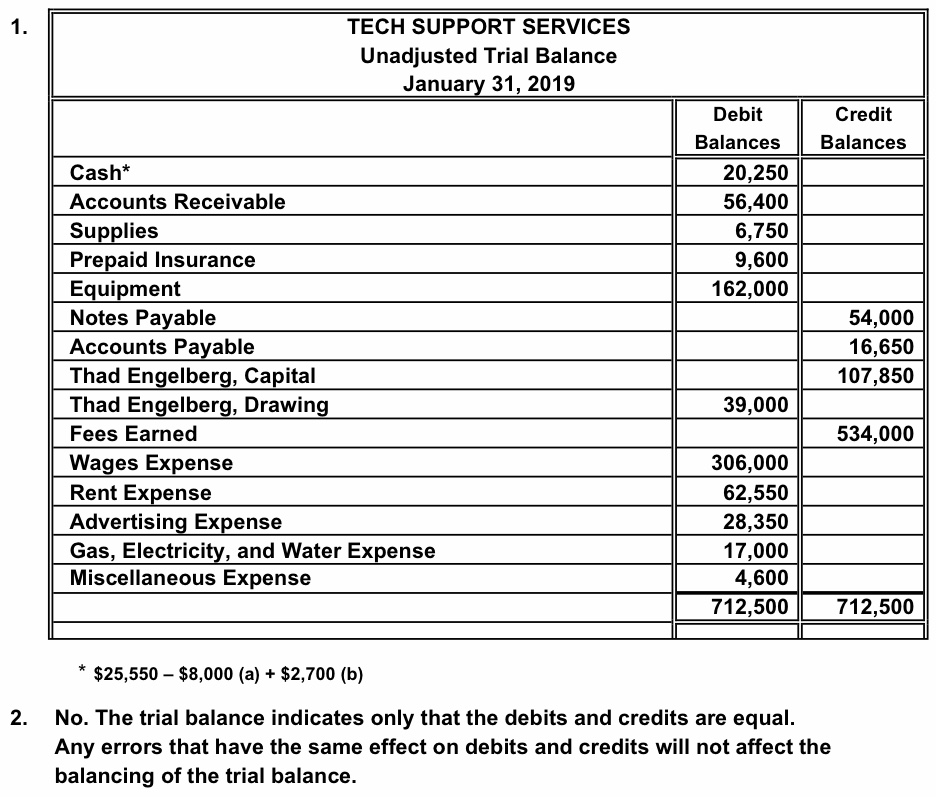Post Closing Trial Balance Explanation and Example

Let’s look at what a trial balance is, how it works, the various types, and examples. After the preparation of an unadjusted trial balance, the next step in the accounting cycle is to pass adjusting entries. The trial balance is used to test the equality between total debits and total credits. Debits and credits of a trial balance must tally to ensure that there are no mathematical errors. However, there still could be mistakes or errors in the accounting systems.
- Unadjusted and Adjusted Trial Balance is done to prepare final accounts which can then be used as a basis for recording adjusting entries to prepare the adjusted trial balance.
- One way to find the error is to take the difference between the two totals and divide the difference by two.
- The beginning trial balance or unadjusted trial balance simply lists the unadjusted balances for each account.
- An unadjusted trial balance is a trial balance which is created before any adjusting entries are made in the ledger accounts.
- Not all accounts in the chart of accounts are included on the TB, however.
- The post-closing trial balance contains real accounts only since all nominal accounts have already been closed at this stage.
To Ensure One Vote Per Person, Please Include the Following Info

Using accounting software like QuickBooks Online can do all these tasks for you behind the scenes. Find an example balance sheet and use our free balance sheet template to review your company’s financial position. All we have to do is to list the balances of all the ledger accounts of a business.
Types of Trial Balance
If the outcome of the difference is a whole number, then you may have transposed a figure. For example, let’s assume the following is the trial balance for Printing Plus. One way to find the error is to take the difference between the two top 10 alternatives to xero totals and divide the difference by two. One of the most well-known financial schemes is that involving the companies Enron Corporation and Arthur Andersen. Enron defrauded thousands by intentionally inflating revenues that did not exist.
Financial and Managerial Accounting
This is the document that lists the accounts and balances before the last adjustments have been made. This unadjusted financial document is prepared based on the general ledger or other sources recording the transactions. As you can see, all the accounts are listed with their account numbers with corresponding balances. In accordance with double entry accounting, both of the debit and credit columns are equal to each other.
While the former is about noting down the transactions roughly, the latter is the means of presenting data in proper order. In order to create a true picture of your business, you should always prepare an income statement and balance sheet for the current month’s closing date. The unadjusted trial balance (UTB) is an important tool for monitoring your company’s operating results.
Difference between adjusted and unadjusted trial balance
It lists all the ledger accounts in a summary form which will later be used in the financial statements. Step by step procedure for preparing an unadjusted trial balance is as follows. While every company maintains a record of its account balances in its general ledger, financial statements can only be complete and accurate if all accounts are prepared accurately. Unadjusted and Adjusted Trial Balance is done to prepare final accounts which can then be used as a basis for recording adjusting entries to prepare the adjusted trial balance. First, the account balances from the general ledger and subsidiary ledgers are transferred to a trial balance. Next, these balances are listed in balance sheet and income statement order with their debit and credit balances.
If a company creates financial statements on a monthly basis, the accountant would print an unadjusted trial balance at the end of each month to initiate the process of creating financial statements. Alternatively, if the company only creates financial statements once a quarter, you would print the unadjusted trial balance on a quarterly basis. These adjusting entries have the effect of making certain that the total debits equal the total credits in each account.
These credit balances would transfer to the credit column on the unadjusted trial balance. There are eight steps in the accounting cycle, the fourth step being the preparation of an unadjusted trial balance. Companies have to have an organized and adjusted trial balance before they prepare their financial statements to reflect the liabilities, assets, revenues, and expenses of the organization.
Business owners and accounting teams rely on the trial balance to create reliable financial statements. A trial balance ensures the accuracy of your accounting system and is just one of the many steps in the accounting cycle. By providing a snapshot of all ledger accounts within a given accounting period, the trial balance helps business owners and accounting teams in reviewing accuracy. Accountants of ABC Company have passed the journal entries in the journal and posts the entries in to their respective ledgers.

